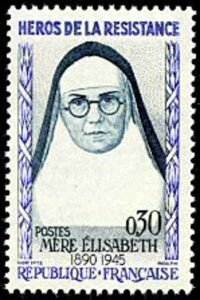Martha Hall Kelly's Blog: Martha's Blog, page 3
March 31, 2023
She’s back. Dr. Herta Oberheuser Returns in The Golden Doves.

Dr. Herta Oberheuser was a German Nazi physician who helped carry out medical experiments on prisoners at the Ravensbruck Concentration Camp for Women.
At the Doctors Trial at Nuremberg, after several Polish former prisoners testified that Herta had participated in the horrific sulfonamide experiments forced on them at the camp, Herta was found guilty on all counts and sentenced to 20 years in prison.

Herta was serving her sentence at Landsberg Prison when she was quietly released after serving only five years, all arranged by the United States military. Like many other Nazi concentration camp doctors, she returned to practicing medicine, and developed a “flourishing medical practice” in northern Germany. There, she was recognized by a Ravensbruck survivor who quickly got word to French survivors, who contacted socialite and activist Caroline Ferriday. Once Caroline heard Herta was free she mounted a campaign, with the help of her physician friends at The British Medical Association, to have the doctor’s medical license revoked.

Herta officially lost her position in August 1958 when her medical license was revoked and her practice shut down. She never practiced medicine again, was fined, and died in a German nursing home in 1978. She was 67 years old.
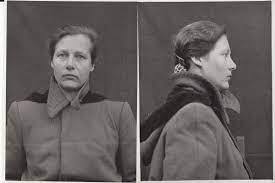
March 30, 2023
It Was So Much Fun Researching the 1950s Lifestyle
 I was born in 1957 and don’t remember what the fifties were like, so I loved going back to that time when researching The Golden Doves, and happily gave Josie’s boss’s wife a plastic-slipcovered sofa.
I was born in 1957 and don’t remember what the fifties were like, so I loved going back to that time when researching The Golden Doves, and happily gave Josie’s boss’s wife a plastic-slipcovered sofa.
Growing up in suburban Massachusetts our across the street neighbors The Aleos had an ultra modern home with white carpet and plastic-slipcovered living room furniture (and copper jello molds hung on the kitchen wall, but that’s another story). On the rare occasion the neighborhood kids were allowed into the house I would stare at the slippery sofa, puzzled by why anyone would want to do that to furniture. I’m relieved that slipcovers have gone away and, unlike the mullet, show no sign of returning.
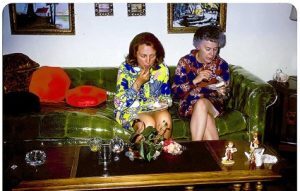


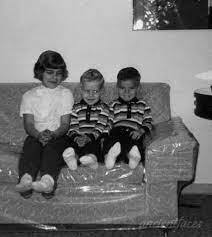
March 28, 2023
Kurt Blome Worked on a Plague Weapon to Try and Please Hitler.

During WWII Hitler reportedly issued orders prohibiting biological weapons. But research was conducted anyway, and Dr. Kurt Blome, Reich Deputy Health Leader, promised the Fuhrer a Wunderwaffe, a miracle weapon that would turn the tide of war in Germany’s favor. He worked with plague, typhoid, cholera and anthrax to develop as weapons to use against the United States, Britain and the Soviet Union.
Himmler had a special interest in weaponizing plague and ordered Blome to experiment with it on concentration camp prisoners to test the efficacy of vaccines. Blome did his research in a secret research center in Posen, in central Poland, which was surrounded by a ten-foot high wall and guarded by a special S.S. unit.
In 1945, as the war started to come to a close, Blome fled his research center and was arrested in Munich in May 1945 by the U.S .Counter Intelligence Corps.
In 1947, Blome was tried at the Nuremberg Doctor’s Trial, charged with experimenting on concentration camp prisoners. During the trial he only admitted he had been ordered to experiment with plague vaccines on the prisoners, and some say that the U.S. saved him from execution in exchange for information about biological warfare, which the Americans were interested in for their own biological weapons programs. After Blome was aquitted they they moved him to Camp King, located north west of Frankfurt, Germany which the United States Army used as an interrogation center and intelligence post.
Jacobsen explains it in an excerpt published on The Daily Beast from her fascinating book Operation Paperclip:
In an offshoot of Operation Paperclip, the CIA teamed up with Army, Air Force and Naval Intelligence to run one of the most nefarious, classified, enhanced interrogation programs of the Cold War. The work took place inside a clandestine facility in the American zone of occupied Germany, called Camp King. The facility’s chief medical doctor was Operation Paperclip’s Dr. Walter Schreiber, the former Surgeon General of the Third Reich. When Dr. Schreiber was secretly brought to America—to work for the U.S. Air Force in Texas—his position was filled with another Paperclip asset, Dr. Kurt Blome, the former Deputy Surgeon General of the Third Reich and the man in charge of the Nazi’s program to weaponize bubonic plague. The activities that went on at Camp King between 1946 and the late 1950s have never been fully accounted for by either the Department of Defense or the CIA.
Later in life Blome returned to practicing medicine in West Germany.
March 26, 2023
Costume Designer Nina Jirsíková Created Her Own Grim Fashion Magazine at Ravensbruck
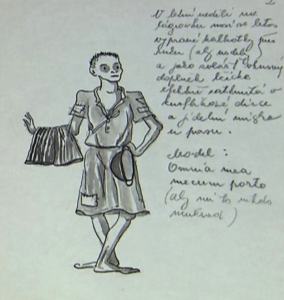
Translation: This year’s fashion trend for a stroll between the camp barracks on the summer Sunday. Washed trousers draped over the forearm (to dry), and as a particularly tasteful accessory – teaspoon compellingly inserted into a buttonhole, and a meal bowl at the waistline. Name of the design: Omnia mea mecum porto {Latin: “All that is mine I carry with me “} (So that nobody steals it from me)

Translation: “This tasteful winter costume is especially suitable for winter morning temperatures (5 in the morning -30°).”
These illustrations sum up the prisoner’s attitudes at Ravensbruck Concentration Concentration Camp for women, a mixture of grim realism and the grit that they needed to survive such harsh conditions. Drawn by prisoner Nina Jirsíková a former dancer, actress, choreographer and costume designer who created a Ravensbruck fashion magazine, it’s her own ironic take on the camp clothing the women were reduced to wearing.
Nina Jirsíková pre-Ravensbruck
Born on February 6, 1910 in Prague, Cechy, Austria-Hungary (now the Czech Republic) Nina also created many illustrations of everyday life at the camp, which I drew upon to bring the camp alive in The Golden Doves.
Nina as Salome in happier times
Nina’s drawings and art by other Ravensbrück artists serves as valuable documentation of the inhumane conditions at the camp, which the staff hid from the world for so long.
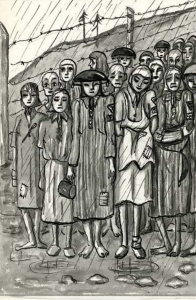
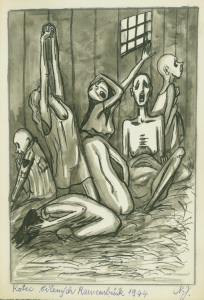

March 24, 2023
Virginia Hall The American Woman Who Outsmarted the Nazis at Every Turn
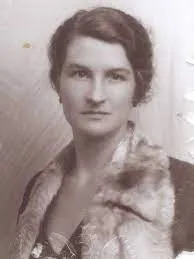
How Virginia Hall, born in Baltimore into a wealthy American family, became so damaging and destructive to the Gestapo in occupied France is one of the best WWII stories I’ve come across, and inspired the espionage storyline in The Golden Doves.
The French Resistance leaders called Virginia la Dame qui boite, the Limping Lady, since she had a wooden leg. To the German Gestapo she was known as Artemis, one of the most hunted Allied spies in France. Virginia was a radio operator and worked for a secret British organization, The Special Operations Executive, SOE, and became one of their most valuable and bravest agents, outwitting the Nazis time and again.
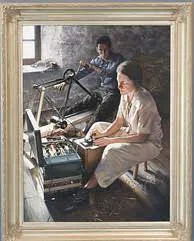
Her story is so beautifully told in A Woman of No Importance by Sonia Purnell, which reads like fiction and makes a great companion read to The Golden Doves.

March 22, 2023
My Journey Tracing the Nazi Ratline Through Italy Ended at the Vatican
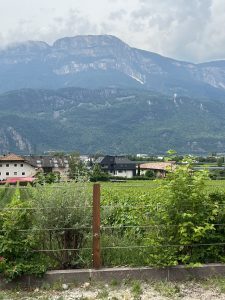 Reading the fascinating book The Ratline by Philippe Sands for research for my novel The Golden Doves sent me on a wild trip through Italy tracing the routes thousands of Nazi fugitives took to escape justice. My husband and I started in Bolzano in Northern Italy in the Dolomite Mountains where Nazis came post WWII from Germany and Austria to hide from the military tribunals taking place after the war. Assisted by Nazi sympathizers, the International Red Cross and the Catholic Church, the men stayed in local homes and monasteries awaiting forged travel documents and passage out of the country.
Reading the fascinating book The Ratline by Philippe Sands for research for my novel The Golden Doves sent me on a wild trip through Italy tracing the routes thousands of Nazi fugitives took to escape justice. My husband and I started in Bolzano in Northern Italy in the Dolomite Mountains where Nazis came post WWII from Germany and Austria to hide from the military tribunals taking place after the war. Assisted by Nazi sympathizers, the International Red Cross and the Catholic Church, the men stayed in local homes and monasteries awaiting forged travel documents and passage out of the country.
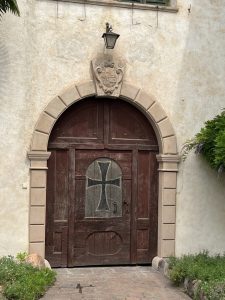


We then took the same train route many of the Nazi fugitives took, from the Bolzano Train Station to the Termini Station in Rome. Once in Rome, we headed to Santa Maria dell’Anima Church where Bishop Alois Hudal, known as the Brown Bishop for his ties to Austria, served as rector, and helped Nazis escape to South America and other safe havens. Declassified CIA documents show that Hudal aided Nazis hoping to flee the country by providing travel documents and a safe haven at his church and at nearby monastery Vigna Pia. Hudal, famous for his 1937 book “The Foundations of National Socialism” in which he praised Hitler and some of his policies, and for helping thousands of Nazis escape justice, only resigned in 1952 under pressure German and Austrian bishops and the Holy See.

Santa Maria dell’Anima Church in Rome
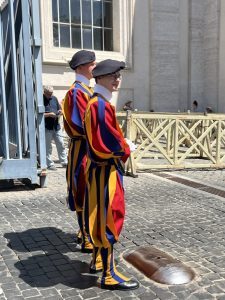
My husband and I joined the line for the tour of the Teutonic Cemetery in Vatican City and were stunned to find that Bishop Hudal is buried there, under the Good Samaritan Station of the Cross.

Bishop Hudal’s burial site under the Good Samaritan Station of the Cross.

Aerial shot of the Teutonic Cemetery in Vatican City

After the trip we came back home and I had plenty of new insights into the Nazi ratline to add to The Golden Doves. Thank you Philippe Sands!

The Only Nazi Lebensborn Home on French Soil is Where Arlette Gives Birth in The Golden Doves

Lamorlaye today
When I was researching Lilac Girls and Herta Oberheuser’s scenes at a Lebensborn Camp, I discovered the bizarre world of the Nazi Lebensborn (spring of life) program. The goal of the program was to create a superior race of Nordic Germans and in order to be admitted to a Lebensborn home both parents had to fit the “Aryan” racial criteria defined by the Hitler regime. There were several Lebensborn homes located throughout Europe but I was especially fascinated by Lamorlaye, the only birthing home established on French soil.The home stood 40 kilometers north of Paris, hidden in the forest of Chantilly, a secluded spot where women, pregnant by members of the SS, could have their babies in private. When it came time to write The Golden Doves I knew this was the perfect setting for my French character Arlette to have her baby, which had been fathered by a Wehrmacht soldier.Once a pretty, Anglo-Norman style residence, with stables and outbuildings, Lamorlaye was requisitioned from the Menier family (of chocolate fame) and had been occupied by the SS since 1942. According to the locals, it was strictly forbidden to approach the mansion perched on the hillside, but many townspeople knew there was a Nazi nursery up there, and that the Germans were recruiting tall blonde women to make Aryan children.Lamorlaye came with its own cast of characters: Oberführer SS Gregor Ebner, chief medical officer of the Lebensborns, a specialist in “racial selection” and personal friend of Heinrich Himmler, head nurse Josefa Knoll, a midwife, and three other nurses, who all make appearances in The Golden Doves.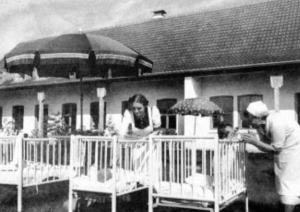 But once the war took a bad turn for Germany, Lamorlaye’s days were numbered. After the Normandy landings in June, 1944, Dr. Ebner wrote: “Learned the news of the invasion at Normandy and informed the mothers. It is becoming more and more difficult to properly feed the 12 babies still present. The garden does not provide enough carrots and spinach.” Days later, a telegram of five lines was sent to Heinrich Himmler’s personal staff in Berlin: “The days of motherhood are numbered.” Lamorlaye was closed that August 1944 and the remaining babies transferred to Munich. Even today some of those children, now grown, are still trying to find their real parents.
But once the war took a bad turn for Germany, Lamorlaye’s days were numbered. After the Normandy landings in June, 1944, Dr. Ebner wrote: “Learned the news of the invasion at Normandy and informed the mothers. It is becoming more and more difficult to properly feed the 12 babies still present. The garden does not provide enough carrots and spinach.” Days later, a telegram of five lines was sent to Heinrich Himmler’s personal staff in Berlin: “The days of motherhood are numbered.” Lamorlaye was closed that August 1944 and the remaining babies transferred to Munich. Even today some of those children, now grown, are still trying to find their real parents. 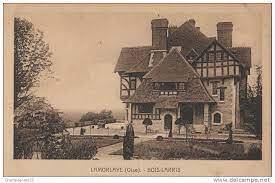
March 19, 2023
Wish We Could All Still Fly Pan Am President’s Class Like Arlette Does in The Golden Doves
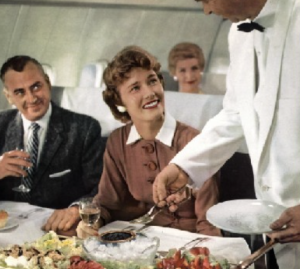
It was so much fun writing the 1950s chapters of The Golden Doves especially the flight the French character Arlette takes, President Class on Pan Am. I loved taking a deep dive into what Pan Am flights were like at the time and let’s just say the meal service may have slipped a little. As I get ready to go out traveling on book tour for Doves, I have a feeling I won’t be dining like this at 35,000 feet. Enjoy this little trip back to the 1950s when you could enjoy a little caviar (and a private breakfast in bed) in the air.

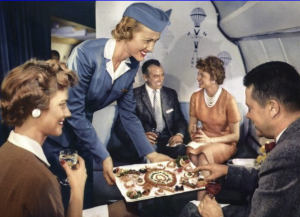
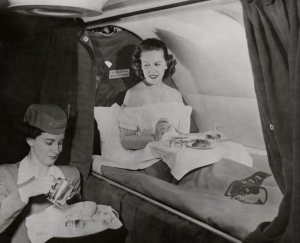


March 16, 2023
The Bizarre Nazi Colony That Inspired the Orphanage in The Golden Doves: Colonia Dignidad
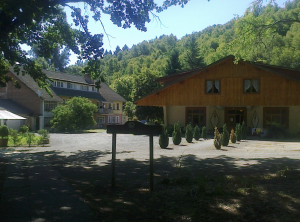
Many of the things about the Nazis post-WWII seem too bizarre to be true, including Colonia Dignidad, but it was all too real. Once I learned of it during my research for my first novel, Lilac Girls I knew I had to use it in a novel one day, and it became the inspiration for my South American setting in The Golden Doves.
Colonia Dignidad was a colony in Chile, settled by a group of emigrant Germans after WWII ended, and became a Nazi stronghold protected by the Chilean government. A highly secret organization, it became home to more than three hundred German and Chilean residents, and housed a school, a hospital, and an airstrip.surrounded by barbed wire and featuring watch towers that could be seen from all parts of the colony.

This cult-like compound was led by Paul Schafer, a former colonel in Hitler’s army who survived the German post-war years under the cover of being a Lutheran pastor and running an orphanage near what was then the West German capital, Bonn. Schafer fled to Chile in 1961, taking many orphans and followers with him, aided by an underground Nazi network in South America.
Colonia Dignidad became notorious for separating local parents from their children, abusing the female children and adults living there, and for medical experiments. The Colony strictly separated genders and when a child was born, it was taken from its parents biological parents and raised by nurses in a group called The Babies. To the outside world, it seemed a prime example of German efficiency, cleanliness and communal work, but later, the abuses were uncovered, including mass graves containing hundreds of bodies. The CIA and Simon Wiesenthal both claimed that Josef Mengele the infamous concentration camp doctor spent time at the colony.
This is just one of many excellent articles about Colonia Dignidad and provides information about The Sinister Sect, the fascinating Netflix series about Colonia Dignidad told in the survivors own words.: https:www.thenation.com/article/culture/sinister-sect-colonia-dignidad/
February 28, 2023
Mother Elisabeth Sacrificed herself at Ravensbruck So a Young Mother Could Live
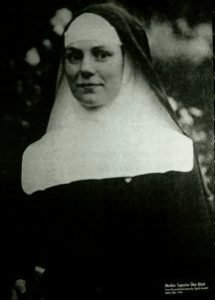
While researching my first novel Lilac Girls I discovered the story of Sister Elise Rivet and have been researching her life for my sixth novel and wanted to share her deeply moving story.
Born in Algeria to an Alsatian mother and a French naval officer father, Élise Rivet grew up in Lyon, France. As a young adult she worked as a hairdresser and then joined the convent of the medical sisters of Notre Dame de Compassion in Lyon in 1912. In 1933 she became the Mother Superior of the convent and took the name Mère Marie Élisabeth de l’Eucharistie.
After France fell to Nazi Germany in World War II she she participated in the Mouvements Unis de Résistance (MUR) and l’Armée Secrète, and hid their archives inside the convent. She also sheltered Jews and a British soldier, gave them identity papers and stored guns and ammunition. On March 24, 1944, Mother Elisabeth was arrested by the Gestapo, along with her assistant Sister Mary Jésus, and taken to Prison in Lyon where she met fellow detainee Andrée Rivière. “It was in the refectory that I saw Mother Elisabeth for the first time, whose personality and radiance came from the most depressed. She welcomed the new boarders with her calm smile which comforted us after the shock of the arrest and prison. All gathered with our Mother, as we called her, we felt a security, a moral support, a supernatural ray of hope and thought that nothing more could happen to us.”
Mother Elisabeth was deported to Ravensbruck Concentration Camp and there, stripped of her religious garments and forced into hard labor, she ministered to her fellow prisoners and helped them turn to prayer to fight their despair.
“Sister Elisabeth was the soul of the camp,” Andrée Rivière said. “In this universe of murderous madness, she was a pole of serenity and hope, of loving presence with her companions.”
Mother Elisabeth spent a year at the camp and just two weeks before Germany surrendered, on March 30, Good Friday, she volunteered to go to the gas chamber in the place of a woman who had children waiting for her at home, saying to her fellow prisoners as they marched: Let we go together. I will help you to die in peace.
She was fifty-five years old.
In 1961 the French government honored Mother Elisabeth with a Heroes of the Resitance postage stamp and a street in Lyon and a lecture hall at the Institut des Sciences he l’Homme in Lyon are named for her.
